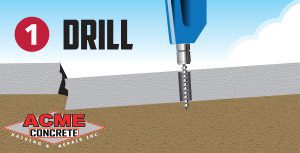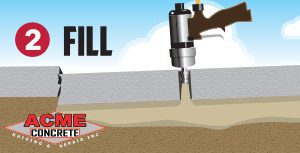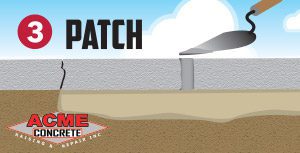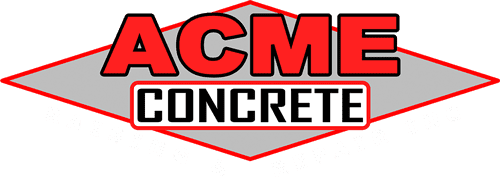How We Raise Settled Concrete with Polyurethane Foam
If a picture is worth a thousand words, video must be even better right? Watch how Acme Concrete raises and stabilizes sunken concrete slabs with expandable polyurethane foam.
Acme Succeeds Where Concrete Fails
Acme’s Smart Lift System is the best polyurethane injection system used to repair concrete structures, including:
Improve your property’s curb appeal and reduce risks for property liability at a faction of the cost and time of concrete replacement. Fix your concrete using a neat, clean, and non-invasive concrete repair process with superior strength and long-lasting results.
Proven, Industrial Strength Concrete Repair
Acme Concrete Raising & Repair’s Smart Lift System is a trusted and proven process for every type of settled concrete flatwork from large highway projects to residential sidewalks. Acme Concrete Raising and Repair is the first and longest running concrete raising contractor in the Chicagoland area focusing specifically on polyurethane injection technology.
Acme’s concrete polyurethane foam raising process provides maximum subgrade strength and costs less than traditional concrete repair or replacement. The Northwest Chicago suburbs are subject to extreme environmental changes — our concrete lifting foams will not shrink or expand due to moisture changes, and will not wash out like aggregate-based slurries used by mudjacking companies.
Fix your concrete using a neat, clean, and non-invasive concrete repair process with superior strength and long-lasting results.

Holes about the size of a dime are drilled into the settled concrete slab. Special injection ports are then installed allowing a clean, controlled injection of the polyurethane lifting foam.

A polyurethane injection gun is securely attached to the ports. Controlled injections are performed resulting in a two-part polymer flowing through the space between the structure and its failed subbase. The polymer forms a structural foam that fills voids while raising and leveling the settled structure.

Once the concrete has been raised, the lifting material is fully cured in about 15-minutes, allowing immediate, unrestricted use of the area. The injection ports are then easily removed and the holes are filled with a high quality grout leaving them virtually unnoticeable.
Who provides concrete leveling foam near you?
Looking for a reliable provider of concrete leveling foam in the Greater Chicago area? Look no further than ACME! Our team offers top-notch solutions for all your concrete leveling needs. From free in-depth inspections to accurate repair estimates, we are committed to providing the best services possible. You can trust ACME for all your concrete leveling needs!
How much does concrete leveling foam cost?
Other than for really small projects, polyurethane concrete leveling costs in the Chicago area typically start at a price of $600. When it comes to leveling sidewalks, the cost depends on three main aspects: the length of the sidewalk, the extent of the drop, and the width of the sidewalk. Each of these factors influences the amount of foam required and thus affects the overall price. For driveways and patios, the base cost for foam leveling is usually in the $750 to $1,500 range. The price depends on the size of the void beneath the slab and the amount of lift needed. Larger voids require more foam and result in increased labor and material costs. Interior concrete slabs, which are often the most expensive types of repairs, require special attention. Sinking slabs within a home are frequently caused by water and sewer line breaks. If left unnoticed, these breaks can create large voids beneath the concrete slab. The size of the void plays a crucial role in determining the amount of foam necessary for lifting the slab. The larger the void, the more foam is needed, resulting in higher labor and material expenses. Overall, the cost of concrete leveling foam varies depending on the specific project, including factors such as labor requirements and the amount of foam needed for proper leveling.
When is concrete leveling foam needed?
Concrete leveling foam is helpful in various situations to address issues with uneven or sunken slabs. These situations include:
1. Soil Erosion: When water washes away the soil beneath a concrete slab, it can cause the slab to sink or become uneven. In such cases, concrete leveling foam can be used to fill the voids and raise the slab back to its original position.
2. Improper Soil Compaction: If the soil underneath a concrete slab was not adequately compacted during construction, it can lead to settlement over time. Concrete leveling foam can be injected below the slab to raise it and provide support, effectively leveling the surface. This process can help compact and stabilize the subgrade.
3. Expansive Soils: Certain types of soil, such as clay, have a tendency to expand and contract with changes in moisture content. This movement can cause the concrete slab to crack or become unlevel. Concrete leveling foam can be used to stabilize the soil and prevent further movement, ensuring a level surface.
4. Tree Root Growth: Tree roots can exert significant force on the ground, causing the concrete slab above to lift or become uneven. In such cases, concrete leveling foam can be used to fill the voids created by the roots. Adjacent sections can be raised to level uneven surfaces and remedy trip hazards.
Overall, concrete leveling foam is needed when there are issues with soil erosion, inadequate soil compaction, expansive soils, or tree root interference, all of which can result in uneven or sunken concrete slabs. This versatile solution helps restore the integrity and levelness of the surface, preventing further damage and providing a safe and stable foundation.
Why does concrete sink?
Concrete sinking is a common issue caused by a variety of factors, including environmental changes and subbase failure. The Northwest Chicago suburbs, known for experiencing extreme environmental fluctuations, often see concrete structures succumb to shifting and settling. This problem is exacerbated by moisture changes that can lead to concrete deterioration. Unlike traditional mudjacking methods that use aggregate-based slurries prone to washing out, our innovative concrete lifting foams offer a durable solution that remains unaffected by moisture variations. By addressing the root causes of concrete sinking and providing a long-lasting remedy, our lifting foams ensure stability and longevity for your concrete structures in the face of challenging environmental conditions.
Water penetrating through cracks in the surface can slowly erode into the base material, weakening its integrity and causing the concrete to sink and crack over time.
If the concrete is built over stone or soil that was not properly compacted, it can lead to quicker sinking and cracking of the concrete.
Concrete can shift and sink with the ground beneath it over time, and this is especially true in climates with extreme season cycles like freeze-thaw cycles.
How can I prevent my concrete from sinking after being raised with polyurethane foam?
To prevent your concrete from sinking after being raised with foam, it’s crucial to address water management around the concrete. One effective method is to redirect water away from the concrete using downspouts and ensuring proper grading of the sides of the slabs to prevent water from washing away the subbase material. Additionally, maintaining the structural integrity is achieved by filling voids with polyurethane foam and applying caulk to gaps and expansion joints to prevent water seepage under the slab. These steps collectively help in preventing concrete sinking and prolong the longevity of the lifted concrete.
How long will raising concrete with foam last?
When concrete is raised using polyurethane foam, the results can last for a considerable amount of time. The synthetic nature of polyurethane foam ensures that it will not break down or change shape easily, reducing the risk of the concrete sinking at the same rate as it likely would if mudjacking mud was used. However, it is essential to acknowledge that while the foam treatment enhances the durability of the concrete, external factors like changes in soil conditions due to frost cycles, poor drainage, or erosion can still impact the stability of the concrete over time.
Why is Polyurethane Concrete Raising becoming a popular choice for repairing concrete slabs?
Polyurethane Concrete Raising has rapidly gained popularity as the preferred method for repairing concrete slabs due to its cost-effectiveness, efficiency, and effectiveness compared to traditional techniques like mudjacking. Polyurethane offers a non-invasive approach that provides a more precise lift, and with multiple formulations, it’s versatile for various projects and applications. Polyurethane is durable and resistant to elements and long-lasting nature, offering minimal maintenance requirements. Overall cost savings further contribute to its appeal as a superior option for repairing sunken concrete.
What are the cost benefits of using Polyurethane Concrete Raising compared to traditional methods?
Acme’s concrete polyurethane foam raising process offers a cost-effective solution for addressing concrete issues in Northern Illinois. Our method ensures maximum subgrade repair and strength while remaining budget-friendly compared to traditional repair or replacement options. In a region prone to extreme environmental changes, our concrete lifting foams stand out for their durability. Unlike aggregate-based slurries used by mudjacking companies, or generic polylift materials, our foams are resistant to shrinking, expanding, or washing out due to moisture fluctuations. This means long-lasting results without the need for frequent maintenance, providing a reliable and affordable alternative for concrete repairs.
How You Can Benefit from Raising Concrete with Polyurethane Foam
Are you tired of dealing with uneven concrete slabs outside your home or workplace? If so, consider the innovative solution of raising and stabilizing sunken concrete using expandable polyurethane foam. Visit our YouTube Channel Take a visual tour of Acme Concrete as we demonstrate our Smart Lift System, a top-tier polyurethane injection system that effectively repairs various concrete structures, including sidewalks, patios, pool decks, steps, porches, stoops, driveways, and garage floors. Acme’s concrete polyurethane foam raising process offers maximum subgrade strength and is a cost-effective alternative to traditional concrete repair or replacement methods. This cutting-edge technique not only enhances your property’s curb appeal but also minimizes property liability risks at a fraction of the cost and time associated with concrete replacement. Unlike aggregate-based slurries used in mudjacking, the polyurethane foam utilized by Acme does not shrink or expand with moisture changes, ensuring long-lasting and reliable results. Say goodbye to the worries of washout issues and say hello to a cleaner, non-invasive concrete repair process that provides superior strength and durability for your concrete surfaces. Benefit from a neat and efficient solution that saves you money in the long term while requiring minimal maintenance. Elevate your concrete surfaces with Acme’s Smart Lift System for a smoother and safer experience!

